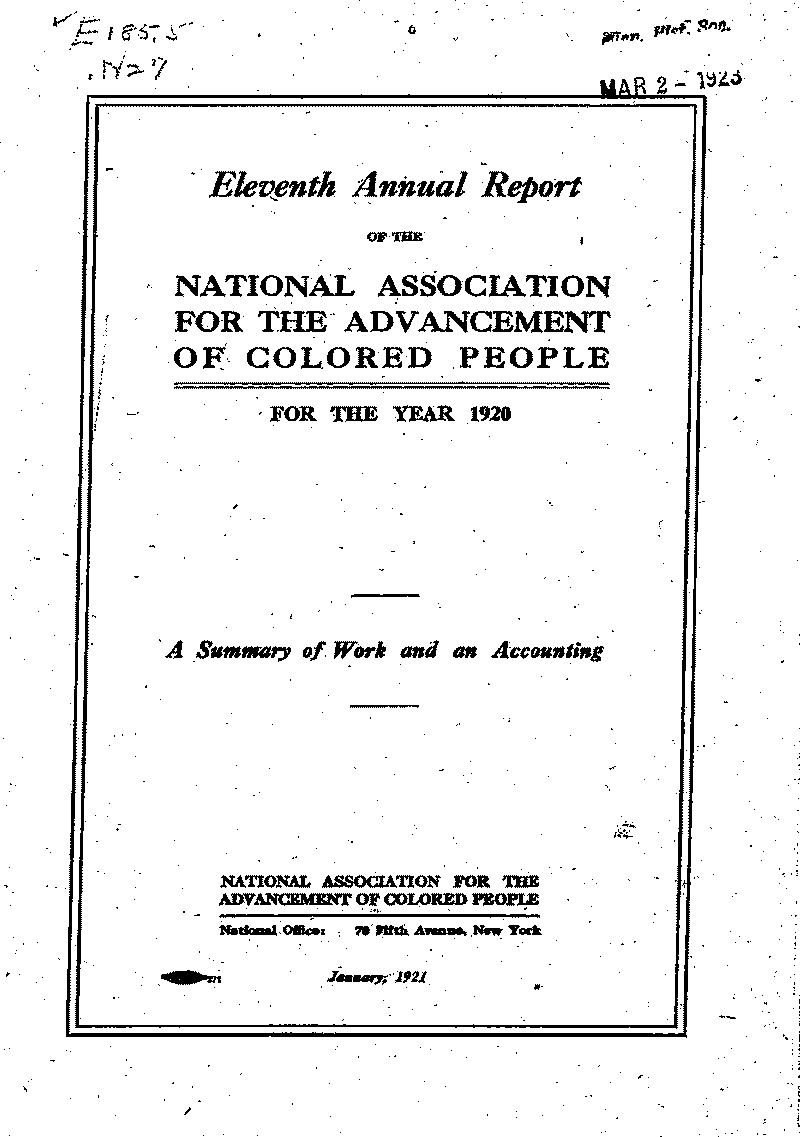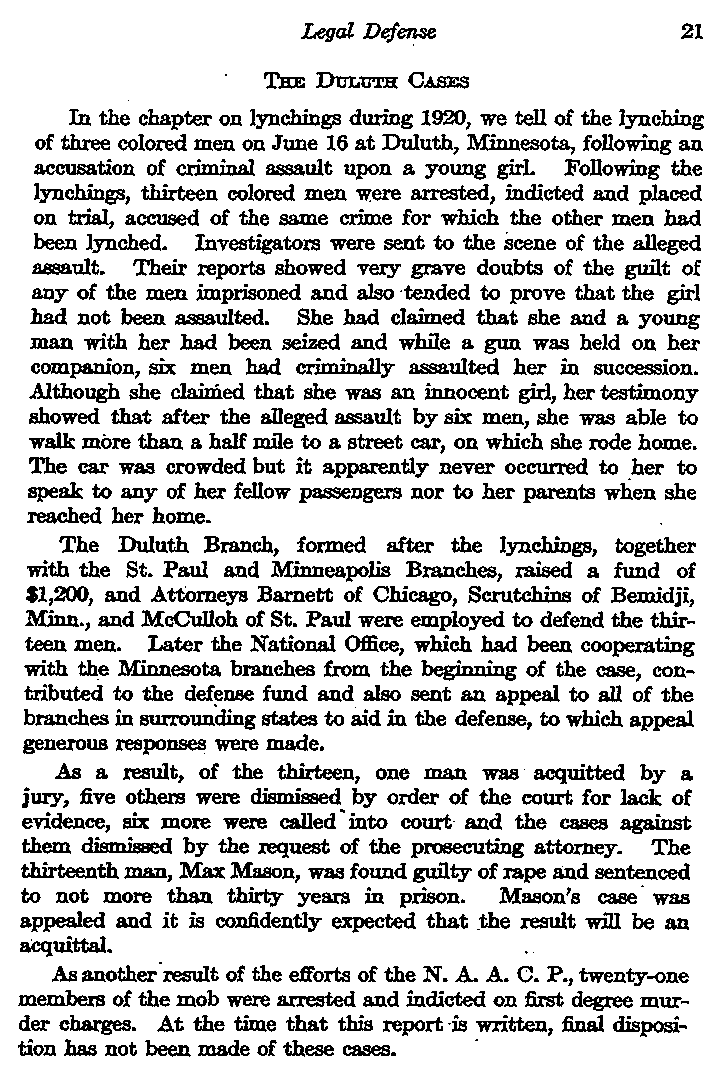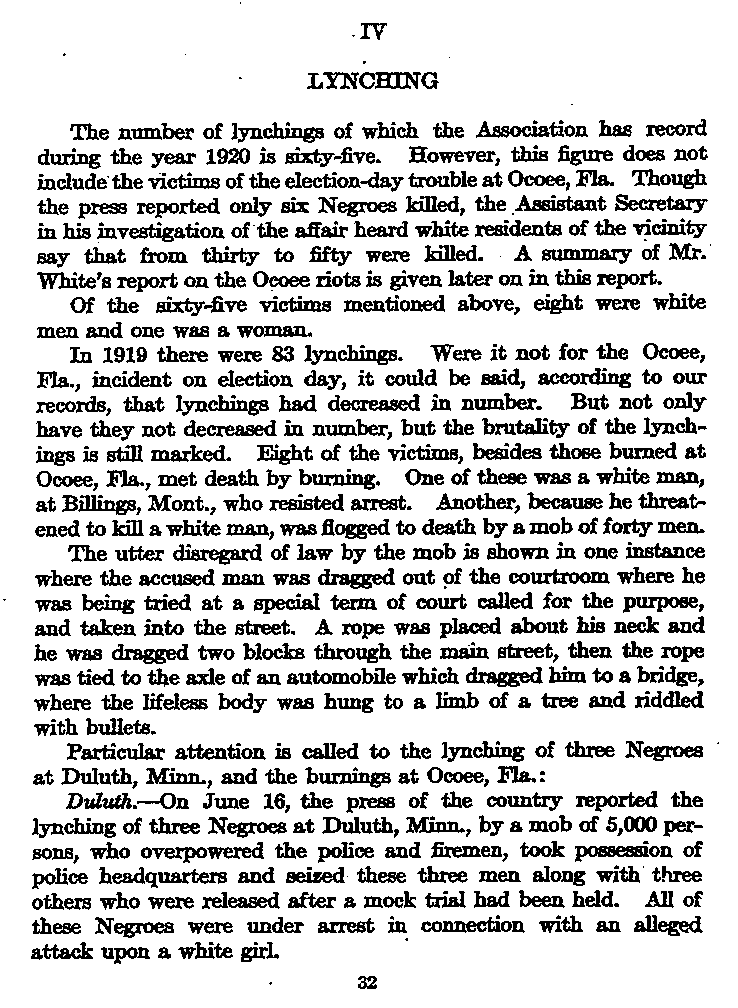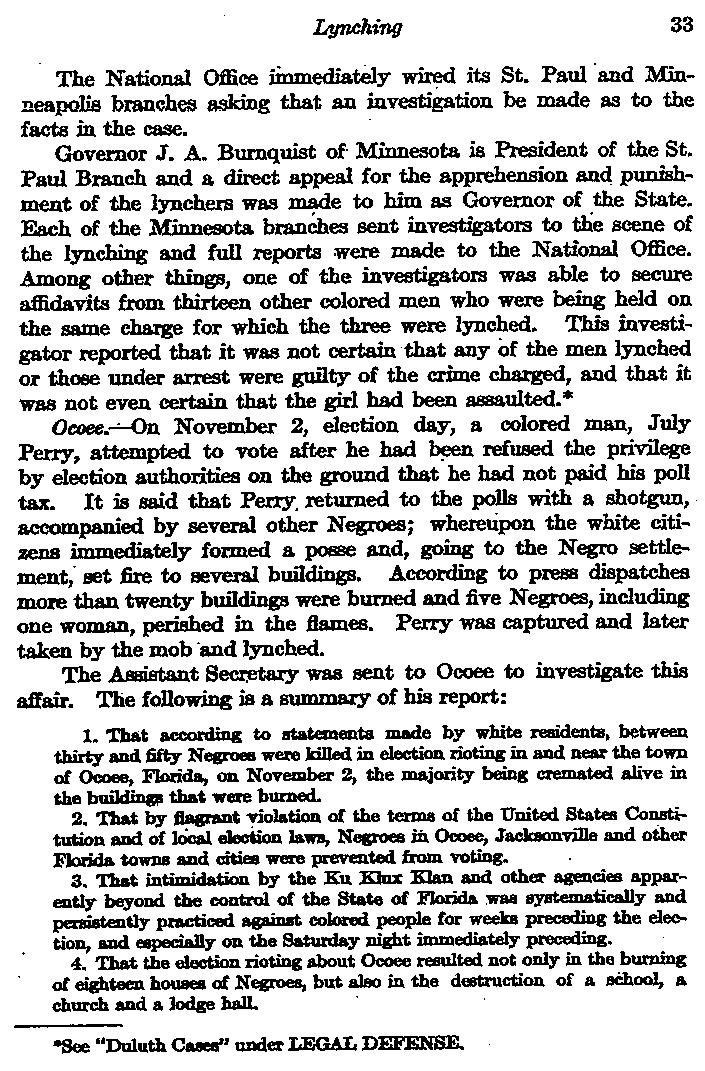Eleventh Annual Report of the National Association for the Advancement of Colored People for the Year 1920. A Summary of Work and an Accounting.
Images




Image text
Legal Defense 21
The Duluth Case
In the chapter on lynchings during 1920, we tell of the lynching of three colored men on June 16 at Duluth, Minnesota, following an accusation of criminal assault upon a young girl. Following the lynchings, thirteen colored men were arrested, indicted and placed on trial, accused of the same crime for which the other men had been lynched. Investigators were sent to the scene of the alleged assault. Their reports showed very grave doubts of the guilt of any of the men imprisoned and also tended to prove that the girl had not been assaulted. She had claimed that she and a young man with her had been seized and while a gun was held on her companion, six men had criminally assaulted her in succession. Although she claimed that she was an innocent girl, her testimony showed that after the alleged assault by six men, she was able to walk more than a half mile to a street car, on which she rode home. The car was crowded but it apparently never occurred to her to speak to any of her fellow passengers nor to her parents when she reached her home.
The Duluth Branch, formed after the lynchings, together with the St. Paul and Minneapolis Branches, raised a fund of $1,200, and Attorneys Barnett of Chicago, Scrutchins of Bemidji, Minn., and McCulloh of St. Paul were employed to defend the thirteen men. Later the National Office, which had been cooperating with the Minnesota branches from the beginning of the case, contributed to the defense fund and also sent an appeal to all of the branches in surrounding states to aid in the defense, to which appeal generous responses were made.
As a result, of the thirteen, one man was acquitted by a jury, five others
were dismissed by order of the court for lack of evidence, six more were called
into court and the cases against them dismissed by the request of the
prosecuting attorney. The thirteenth man, Max Mason, was found guilty of rape
and sentenced to not more than thirty years in prison.
Mason's case was appealed and it is confidently expected that the
result will be an acquittal.
As another result of the efforts of the
N.A.A.C.P., twenty-one members of the mob were arrested and indicted on first
degree murder charges. At the time that this report is written, final
disposition has not been made of these cases.
IV
LYNCHING
The number of lynchings of which the Association has record during the year 1920 is sixty-five. However, this figure does not include the victims of the election-day trouble at Ocoee, Fla. Though the press reported only six Negroes killed, the Assistant Secretary in his investigation of the affair heard white residents of the vicinity say that from thirty to fifty were killed. A summary of Mr. White's report on the Ocoee riots is given later on in this report.
Of the sixty-five victims mentioned above, eight were white men and one was a woman.
In 1919 there were 83 lynchings. Were it not for the Ocoee, Fla., incident on election day, it could be said, according to our records, that lynchings had decreased in number. But not only have they not decreased in number, but the brutality of the lynchings is still marked. Eight of the victims, besides those burned at Ocoee, Fla., met death by burning. One of these was a white man, at Billings, Mont., who resisted arrest. Another, because he threatened to kill a white man, was flogged to death by a mob of forty men.
The utter disregard of law by the mob is shown in one instance where the accused man was dragged out of the courtroom where he was being tried at a special term of court called for the purpose, and taken into the street. A rope was placed about his neck and he was dragged two blocks through the main street, then the rope was tied to the axle of an automobile which dragged him to a bridge, where the lifeless body was hung to a limb of a tree and riddled with bullets.
Particular attention is called to the lynching of three Negroes at Duluth, Minn., and the burnings at Ogee, Fla.:
Duluth.-On June 16, the press of the country reported the
lynching of three Negroes at Duluth, Minn., by a mob of 5,000 persons, who
overpowered the police and firemen, took possession of police headquarters and
seized these three men along with three others who were released after a mock
trial had been held. All of these Negroes were under arrest in connection with
an alleged attack upon a white girl.
32
Lynching 33
The National Office immediately wired its St. Paul and Minneapolis branches
asking that an investigation be made as to the facts in the
case.
Governor J. A. Bumquist of Minnesota is President of the
St. Paul Branch and a direct appeal for the apprehension and punishment of
the lynchers was made to him as Governor of the State. Each of the Minnesota
branches sent investigators to the scene of the lynching and full reports were
made to the National Office. Among other things, one of the investigators was
able to secure affidavits from thirteen other colored men who were being held on
the same charge for which the three were lynched. This investigator reported
that it was not certain that any of the men lynched or those under arrest were
guilty of the crime charged, and that it was not even certain that the girl had
been assaulted.*
Ocoee.--On November 2, election day, a colored man,
July Perry, attempted to vote after he had been refused the privilege by
election authorities on the ground that he had not paid his poll tax. It is said
that Perry returned to the polls with a shotgun, accompanied by several other
Negroes; whereupon the white citizens immediately formed a posse and, going to
the Negro settlement, set fire to several buildings. According to press
dispatches more than twenty buildings were burned and five Negroes, including
one woman, perished in the flames. Perry was captured and later taken by the mob
and lynched.
The Assistant secretary was sent to Ogee to investigate
this affair. The following is a summary of his report:
1. That according to statements made by white residents, between thirty and fifty Negroes were killed in election rioting in and near the town of Ocoee, Florida, on November 2, the majority being cremated alive in the best were burned.
2. That by flagrant violation of the terms of the United States Constitution and of local election laws, Negroes in Ocoee, Jacksonville and other Florida towns and cities were prevented from voting.
3. That intimidation by the Ku Klux Klan and other agencies apparently beyond the control of the State of Florida was systematically and persistently practiced against colored people for weeks preceding the election, and especially on the Saturday night immediately preceding.
4. That the election rioting about Ocoee resulted not only in the burning of
eighteen houses of Negroes, but also in the destruction of a school, a church
and a lodge hall.
*See "Duluth Cases" under LEGAL DEFENSE.

